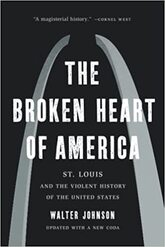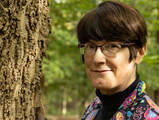A must read for anyone with ties to St. Louis and everyone who yearns for a brighter future.

I got The Broken Heart of America from my local library as background on St. Louis history for an essay I'm contributing to a St. Louis Writers Guild anthology. Wow. I had no idea how many “whitewashed” myths about my city were untrue.
The 1904 World’s Fair, often considered the highmark of St. Louis history, was a segregated affair that banned ragtime music from the grounds and staged the “largest human zoo in world history.” St. Louis was a staging post for Indian removal and imperial expansion throughout the 1800s, and this shameful legacy was celebrated at the fair by displaying fifty-one of the First Nations of North America, among other “primitive” peoples.
The iconic Gateway Arch was built on land first taken from the Osage Nation, then from thriving Black businesses in 1939, when city leaders bulldozed 40 blocks of the riverfront. Thirty years later, two protestors scaled the Arch in 1964 while it was under construction, objecting to the complete exclusion of Black workers from construction crews.
Written by a Harvard University professor, this book is filled with hard-hitting facts painting a legacy of racist bigotry--but also ordinary citizens joining together to create a more inclusive and equitable city.
The book's epilogue reminds me of a line from the Desiderata: “With all its sham, drudgery, and broken dreams, it is still a beautiful world.”
The 1904 World’s Fair, often considered the highmark of St. Louis history, was a segregated affair that banned ragtime music from the grounds and staged the “largest human zoo in world history.” St. Louis was a staging post for Indian removal and imperial expansion throughout the 1800s, and this shameful legacy was celebrated at the fair by displaying fifty-one of the First Nations of North America, among other “primitive” peoples.
The iconic Gateway Arch was built on land first taken from the Osage Nation, then from thriving Black businesses in 1939, when city leaders bulldozed 40 blocks of the riverfront. Thirty years later, two protestors scaled the Arch in 1964 while it was under construction, objecting to the complete exclusion of Black workers from construction crews.
Written by a Harvard University professor, this book is filled with hard-hitting facts painting a legacy of racist bigotry--but also ordinary citizens joining together to create a more inclusive and equitable city.
The book's epilogue reminds me of a line from the Desiderata: “With all its sham, drudgery, and broken dreams, it is still a beautiful world.”

 RSS Feed
RSS Feed